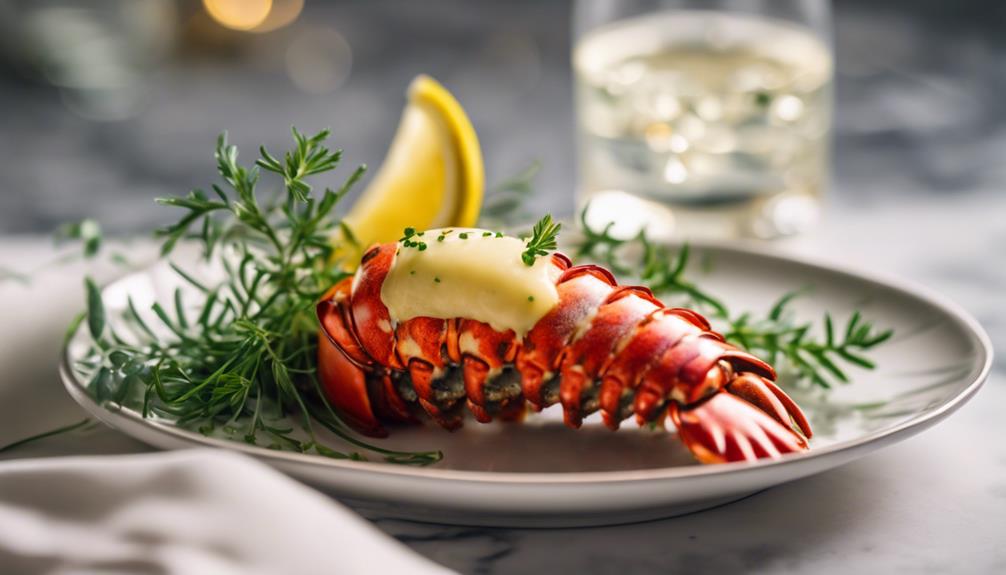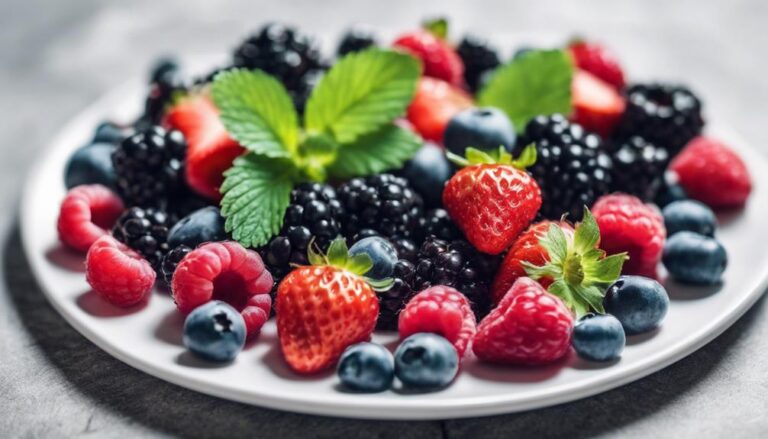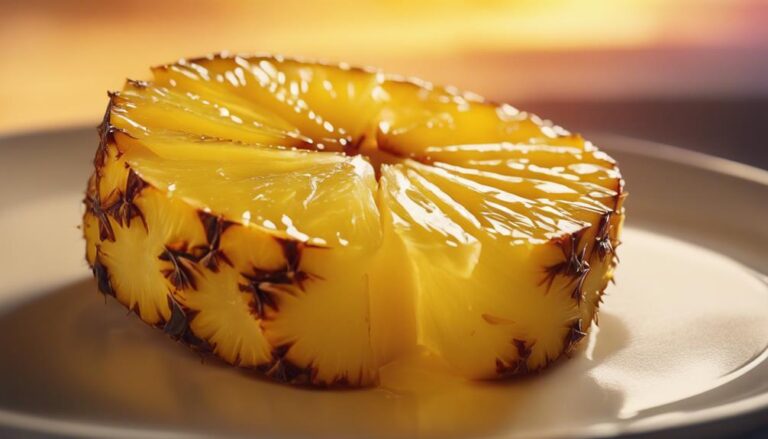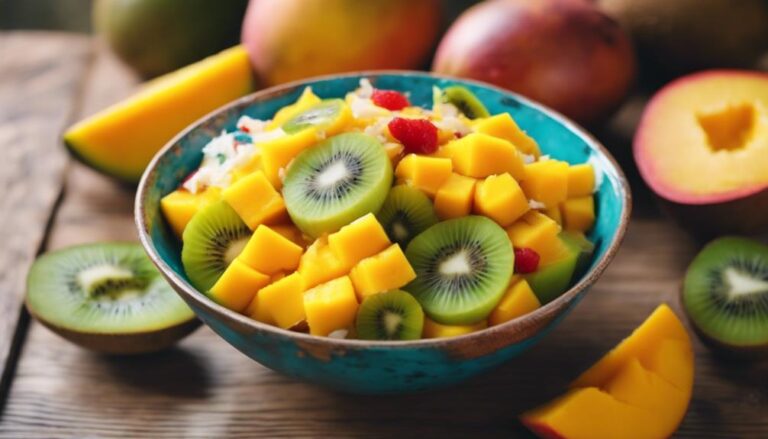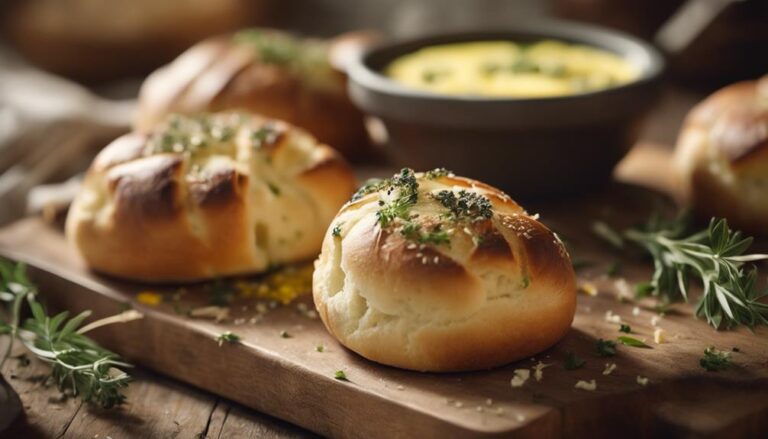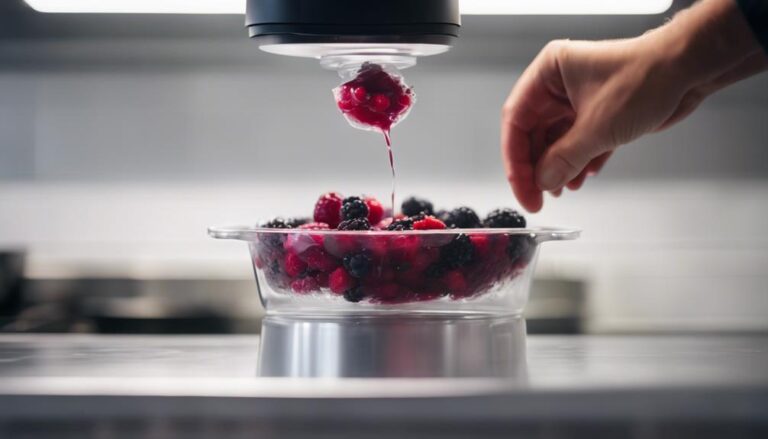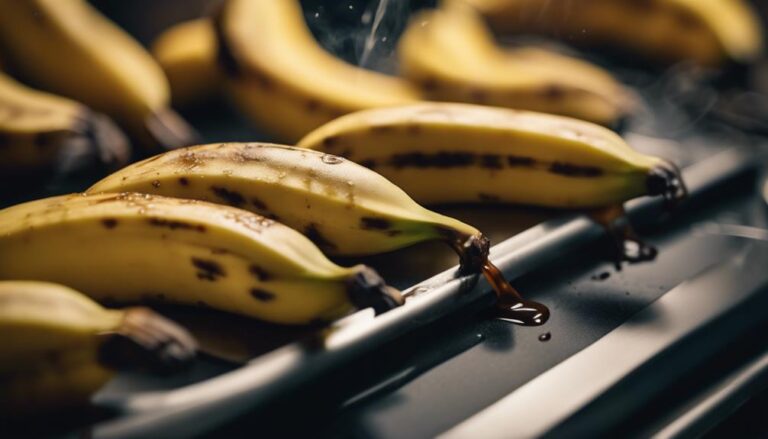Sous Vide Lobster Tail With Clarified Butter
To sous vide lobster tail with clarified butter, start by vacuum-sealing the lobster tail with a pat of clarified butter. Set your sous vide water bath to 140°F and immerse the sealed lobster tail for 45 minutes. Afterwards, remove the lobster tail, gently pat it dry, and sear briefly in a hot pan for color. Serve the tender lobster tail with more clarified butter for dipping. Experience the exquisite tenderness and rich flavor of lobster tailor-made to perfection. Ready to discover more about enhancing your culinary skills with sous vide cooking techniques?
What You Will Learn Here
- Clarified butter adds richness to sous vide lobster tail.
- Enhances flavors without overpowering the delicate lobster taste.
- Provides a luxurious finish and velvety texture to the dish.
- Balances the natural sweetness of lobster with a buttery touch.
- Elevates the overall dining experience with a classic pairing.
Sous Vide Lobster Tail Origins
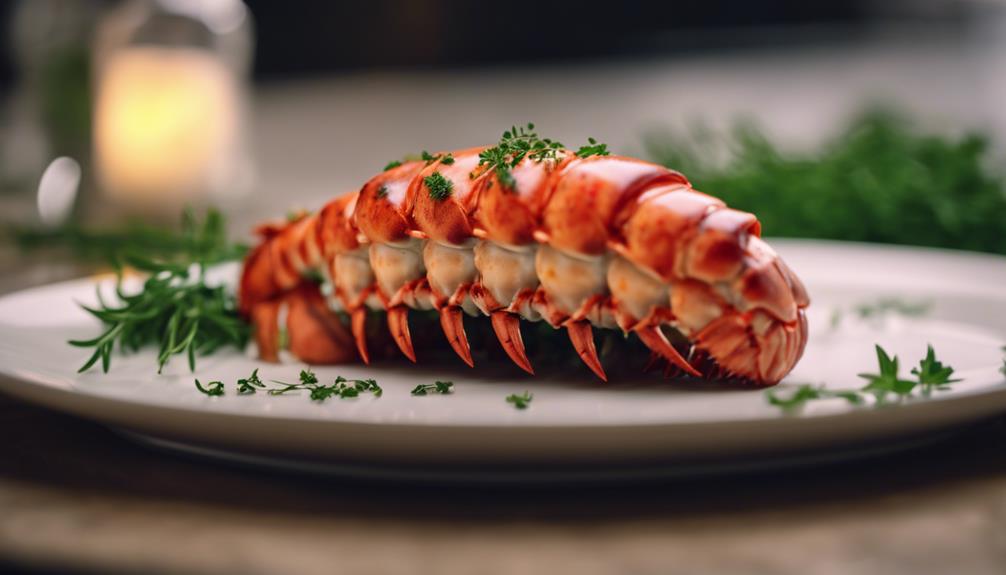
The origins of sous vide lobster tail encompass a blend of historical culinary traditions, modern sous vide techniques, and the innovative impact on contemporary gastronomy.
Lobster tail preparation has evolved over time, adapting to new cooking methods like sous vide to enhance flavors and textures.
Exploring the roots of this dish sheds light on the intersection of culinary history and technological advancements in the kitchen.
Historical Lobster Tail
When exploring the origins of sous vide lobster tail, you uncover a rich history of culinary experimentation and innovation. Lobster, once considered a food for the less fortunate and even used as fertilizer, gained popularity in the mid-19th century. Wealthy diners in Europe and America began to appreciate lobster for its delicate flavor and luxurious appeal.
The practice of cooking lobster sous vide, meaning 'under vacuum' in French, traces back to the early 1970s when French chefs aimed to enhance the tenderness and flavor of various foods. By vacuum-sealing lobster tails and cooking them in precisely controlled water baths, chefs could achieve unparalleled texture and taste. This technique revolutionized the way lobster was prepared, offering a consistent and delectable dining experience.
Today, sous vide lobster tail has become a staple in fine dining establishments and home kitchens alike, allowing individuals to savor the decadence of lobster with unparalleled succulence and flavor.
Sous Vide Technique
To understand the origins of sous vide lobster tail, explore the innovative technique of vacuum-sealing and precisely controlled water baths used by French chefs in the early 1970s. This method revolutionized the culinary world by guaranteeing that ingredients can be cooked at lower temperatures for extended periods, resulting in enhanced flavors and textures. The term 'sous vide' itself translates to 'under vacuum' in French, highlighting the importance of sealing the food in airtight bags before submerging it in the water bath.
French chef Georges Pralus is often credited with pioneering the sous vide technique, initially using it to cook foie gras. The precise temperature control in sous vide cooking ensures that the food is cooked evenly from edge to edge, preserving its natural juices and maximizing tenderness. Over time, this technique gained popularity in professional kitchens worldwide, leading to its adaptation for home cooks seeking restaurant-quality results.
The evolution of sous vide has paved the way for a new era of precision cooking, making it possible to achieve consistent and delectable dishes like sous vide lobster tail with clarified butter.
Culinary Innovation Impact
Embracing the sous vide technique for lobster tail has undeniably revolutionized culinary innovation, elevating the dining experience with unparalleled precision and flavor enhancement. This method involves vacuum-sealing the lobster tail with seasonings and immersing it in a precisely controlled water bath for an extended period. The sous vide process guarantees that the lobster tail cooks evenly from edge to edge, resulting in a tender, succulent texture that traditional cooking methods often struggle to achieve.
The impact of sous vide on lobster tail preparation goes beyond just consistency and texture. By cooking the lobster tail at a precise temperature for an extended period, flavors are allowed to develop fully, enhancing the natural sweetness and delicate taste of the lobster meat. This technique also minimizes the risk of overcooking, preserving the tenderness and juiciness of the lobster tail.
In essence, the sous vide method has redefined how lobster tail is cooked, offering chefs and home cooks alike a more controlled and flavorful approach to preparing this prized seafood delicacy.
Key Lobster Tail Components
For a delectable lobster tail dish, understanding the key components is essential. When preparing lobster tails, the quality of the ingredients and the cooking method can greatly impact the final taste and texture. Here are three key components to keep in mind:
- Freshness: The freshness of the lobster tail is paramount. Look for lobster tails that are still alive or have been flash-frozen to preserve their quality. Fresh lobster will have a sweet, delicate flavor that enhances the overall dish.
- Size: The size of the lobster tail matters when it comes to cooking time and portion control. Larger tails will take longer to cook and may provide a heartier portion, while smaller tails cook more quickly and are suitable for smaller appetites or as part of a larger meal.
- Seasonings: Seasonings play an important role in enhancing the natural flavors of the lobster tail. Common seasonings include salt, pepper, garlic, lemon, and herbs like parsley or tarragon. Balancing the seasonings is essential to complementing the lobster without overpowering its delicate taste.
Tasty Lobster Tail Variations
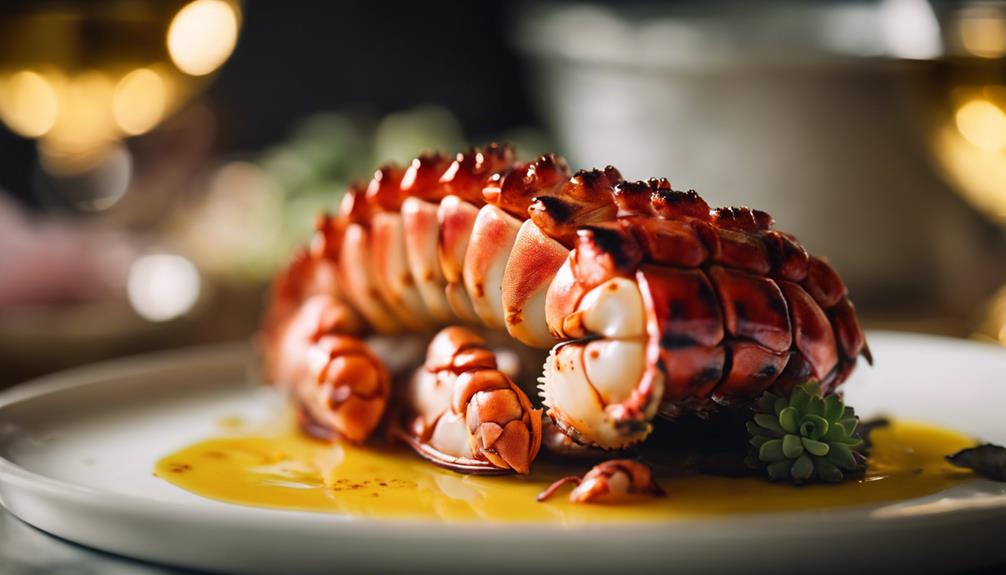
When it comes to lobster tail variations, you have a few delectable options to explore. Try a mouthwatering lobster tail medley, indulge in a luxurious butter-poached lobster tail, or savor the flavors of a hearty lobster tail stew.
These variations offer unique ways to enjoy the rich taste of lobster tails, adding a touch of culinary creativity to your dining experience. Explore these tasty options to elevate your lobster tail dishes to a whole new level of deliciousness.
Delicious Lobster Tail Medley
Indulge in a delectable array of lobster tail variations that will tantalize your taste buds with each succulent bite. Whether you prefer classic flavors or more adventurous combinations, there's a lobster tail medley to suit every palate. Here are three mouthwatering variations to elevate your dining experience:
- Garlic Butter Lobster Tail: Succulent lobster tail bathed in a rich garlic butter sauce, enhancing the natural sweetness of the meat with a subtle hint of garlic. This indulgent dish is a timeless favorite for garlic lovers.
- Invigorating Herb Lobster Tail: A invigorating twist on traditional lobster tail, this variation features zesty lemon and aromatic herbs like parsley and thyme. The bright flavors complement the delicate lobster meat beautifully.
- Spicy Cajun Lobster Tail: For those craving a bit of heat, the spicy Cajun lobster tail is a fiery delight. Seasoned with a bold blend of Cajun spices, this dish packs a flavorful punch that will leave your taste buds tingling with excitement.
Butter-Poached Lobster Tail
Let's explore the delicious world of butter-poached lobster tail, a luxurious culinary delight that will elevate your dining experience to new heights. Butter-poaching lobster tail involves cooking the delicate meat in butter at a low temperature, resulting in a tender and flavorful dish that melts in your mouth.
Here are some key points to enhance your understanding:
- Gentle Cooking: Butter-poaching involves simmering the lobster tail in melted butter, allowing the meat to gently cook without overcooking or losing its natural juices.
- Rich Flavor Infusion: The butter not only cooks the lobster tail but also imparts a rich, velvety flavor to the meat, enhancing its natural sweetness.
- Luxurious Texture: The slow cooking process in butter yields a luxurious texture to the lobster tail, making each bite a decadent experience.
Butter-poached lobster tail is a sophisticated and indulgent dish perfect for special occasions or when you want to treat yourself to a culinary masterpiece.
Savory Lobster Tail Stew
To further explore your lobster tail culinary repertoire, consider venturing into the delectable domain of savory lobster tail stew, offering a delightful twist on traditional lobster tail preparations. This rich and hearty dish combines the succulent flavors of tender lobster meat with a savory broth, creating a comforting and satisfying meal. Here are three key reasons why you should immerse yourself in the world of savory lobster tail stew:
- Depth of Flavor: The slow cooking process allows the flavors to meld together, resulting in a complex and delicious taste profile that will tantalize your taste buds.
- Versatility: Lobster tail stew can be customized with a variety of herbs, spices, and vegetables to suit your preferences, making it a versatile dish that can be adapted to different flavor profiles.
- Comforting Warmth: Enjoying a steaming bowl of savory lobster tail stew isn't only a treat for your palate but also a comforting experience that warms you from the inside out, perfect for cozy nights in or gatherings with loved ones.
Sous Vide Lobster Tail Secrets
When preparing sous vide lobster tail, remember these key secrets:
- Keep an eye on cooking times for the perfect texture.
- Employ flavor tricks to enhance the taste.
- Maintain precise temperature control throughout the process.
Cooking Time Tips
For perfect sous vide lobster tail, make sure you adhere to precise cooking times to achieve ideal tenderness and flavor. Cooking times can vary depending on the size of the lobster tail. A general guideline is to cook small tails, around 4-6 ounces, for 30-45 minutes at 135°F (57°C) for a tender and juicy result.
Larger tails, weighing 8-10 ounces, may require 45-60 minutes at the same temperature to make certain they're cooked through evenly. It's important to remember that overcooking lobster can result in a rubbery texture, so sticking to the recommended times is vital.
To guarantee precise cooking times, consider using a reliable sous vide machine with accurate temperature control. This method allows you to cook the lobster tail slowly and gently in a water bath, preserving its natural juices and tenderness.
Flavor Enhancement Tricks
Considering your desire for an exquisite dining experience, infuse your sous vide lobster tail with irresistible flavors through these expert 'Flavor Enhancement Tricks.' To elevate the taste of your lobster tail, start by marinating it in a mixture of olive oil, garlic, lemon juice, and a sprinkle of smoked paprika. This marinade will penetrate the meat, adding depth and complexity to each bite.
Another technique to enhance the flavor is to add fresh herbs like thyme or tarragon into the sous vide bag before cooking. These herbs will infuse the lobster with aromatic notes that complement its natural sweetness. Additionally, a touch of white wine or a splash of brandy can bring a subtle richness to the dish.
For a final burst of flavor, consider finishing the lobster tail with a drizzle of clarified butter infused with a hint of garlic and a squeeze of fresh lemon juice. This decadent sauce will coat the lobster in a luxurious richness that will leave your taste buds yearning for more.
Temperature Control Importance
Maintaining precise temperature control is vital when preparing sous vide lobster tail to guarantee perfect doneness and ideal texture. In sous vide cooking, the water bath is set to a specific temperature, and the lobster tail is vacuum-sealed in a bag, then immersed in the water for slow, gentle cooking.
The essential temperature control is critical because it determines the final outcome of your lobster tail. If the temperature is too high, the lobster meat can become tough and overcooked. On the other hand, if the temperature is too low, the lobster mightn't reach the desired level of doneness, leaving it undercooked.
Final Thoughts
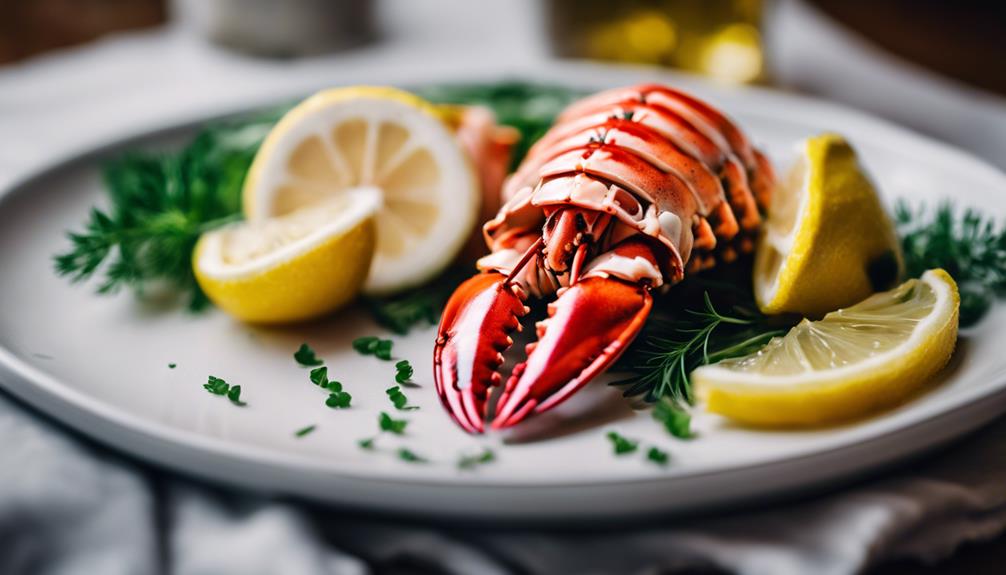
As you reflect on your sous vide lobster tail experience, consider the importance of flavors and textures that the clarified butter brought to the dish. The gentle cooking method of sous vide ensured that the lobster tail was perfectly tender and juicy, allowing you to savor every bite without worrying about overcooking. The clarified butter, with its rich and silky smooth consistency, added a luxurious touch to the dish, enhancing the natural sweetness of the lobster meat.
The precise temperature control maintained throughout the sous vide process played a vital role in achieving the desired doneness of the lobster tail. By cooking the lobster at a consistent temperature, you were able to preserve its delicate flavor and succulent texture, resulting in a truly delightful dining experience. The clarified butter, infused with aromatic herbs and a hint of lemon, complemented the lobster beautifully, elevating its taste to a whole new level.
Frequently Asked Questions
Can I Use Frozen Lobster Tails for Sous Vide Cooking?
Yes, you can use frozen lobster tails for sous vide cooking. Make sure they are properly thawed before vacuum sealing. Frozen tails might require slightly longer cooking times. Follow your recipe's guidelines for best results.
How Can I Prevent the Lobster Tail From Becoming Rubbery?
To prevent your lobster tail from becoming rubbery, make sure not to overcook it. Use a precise sous vide temperature and time based on the size of the tail. Finish with a quick sear for texture. Enjoy the succulent results.
Is It Necessary to Use Clarified Butter for This Dish?
Yes, it's recommended to use clarified butter for a smoother texture and richer flavor. The process removes milk solids, preventing the butter from burning. It's not necessary, but it enhances the dish. Try it!
Can I Sous Vide Lobster Tails With the Shell On?
Yes, you can sous vide lobster tails with the shell on. This method can help maintain moisture and flavor. Make sure the shells are clean and intact to prevent any unwanted flavors from seeping into the meat during the cooking process.
What Temperature Should the Water Bath Be Set to for Sous Vide Lobster Tail?
Set your water bath to 140°F for sous vide lobster tails. This temperature guarantees tender, juicy meat without overcooking. Enjoy precise cooking results by maintaining the water temperature throughout the cooking process. Perfectly cooked lobster awaits!
Conclusion
To sum up, sous vide lobster tail with clarified butter is a delicious dish that can be easily prepared at home. By using precise cooking techniques and quality ingredients, you can elevate the flavors of the lobster tail and create a gourmet dining experience.
Experimenting with different seasonings and accompaniments can add a unique twist to this classic dish. So next time you're craving lobster, consider trying out this sous vide method for a perfectly cooked and flavorful meal.
